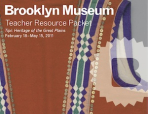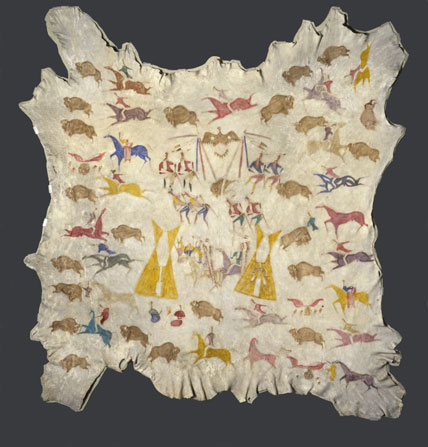
Cadzi Cody (Cotsiogo) (Shoshone, 1866–1912). Painted Robe, circa 1900. Wyoming. Elk hide, pigment, approx. 81 × 78 in. (205.7 × 198.1 cm). Brooklyn Museum, Dick S. Ramsay Fund, 64.13

Cadzi Cody (Cotsiogo) (Shoshone, 1866–1912). Painted Robe, circa 1900. Wyoming. Elk hide, pigment, approx. 81 × 78 in. (205.7 × 198.1 cm). Brooklyn Museum, Dick S. Ramsay Fund, 64.13
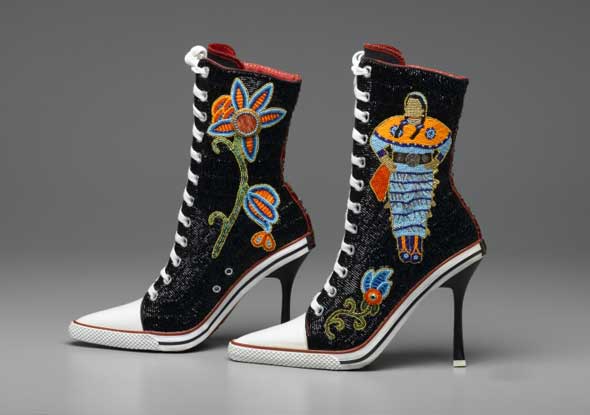
Teri Greeves (Kiowa, b. 1970). Great Lakes Girls, 2008. Glass beads, bugle beads, Swarovski crystals, sterling silver stamped conchos, spiny-oyster shell cabochons, canvas high-heeled sneakers, 111⁄2 x 9 × 3 in. (29.2 × 22.9 × 7.6 cm). Brooklyn Museum, Gift of Stanley J. Love, by exchange, 2009.1a-b
Moccasin styles and designs varied from tribe to tribe. Boys and men usually wore short moccasins. In some tribes, girls and women wore low-top moccasins but with separate knee-high leggings. Among other groups, such as the Kiowa and Cheyenne, they wore one-piece, tall moccasins. Teri Greeves presents a playful contemporary interpretation of Kiowa women’s footwear.
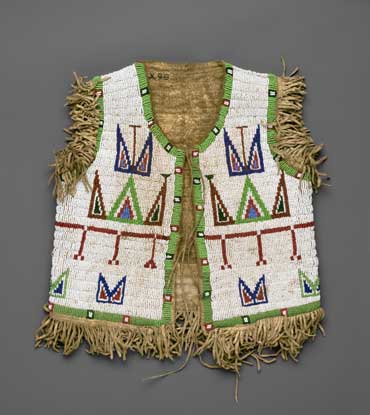
Sioux artist. Boy’s Vest, late 19th century. Northern Plains. Hide, glass beads, 131⁄2 x 121⁄4 in. (34.3 × 31.1 cm). Brooklyn Museum, Brooklyn Museum Collection, X98
Plains parents showered their children with beautifully made clothing for special occasions despite the fact that the garments were soon outgrown. This vest demonstrates how Sioux women re-created the cuts of European clothing in buckskin, covering them with fully beaded geometric designs and bold color combinations on fields of white.
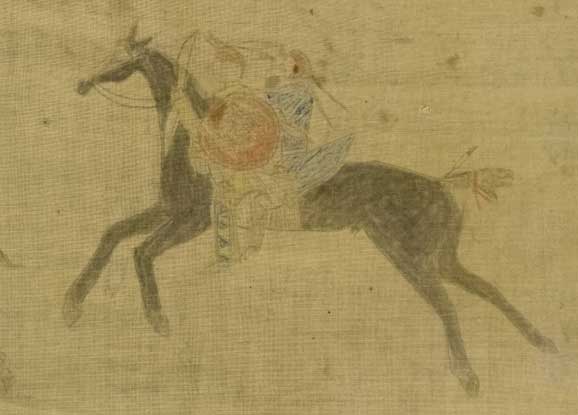
Rain-in-the-Face (Ité Omágaˇzu) (Húnkpapa Lakota, circa 1835–1905). Tipi Liner (detail), 1889. Standing Rock Reservation, North Dakota. Cotton, pigment, crayon, pencil, 6711⁄16 x 20115⁄16 in. (172 × 513 cm). Brooklyn Museum, Frank L. Babbott Fund, 43.221.1
This is a rare example of a tipi liner from earlier Reservation times (1880–1920) painted by a known warrior, Rain-in-the-Face (Ité Omágaˇzu). While visiting Standing Rock reservation, the artist Edwin Willard Deming watched Rain-in-the-Face paint the liner, which the warrior then presented to him as a gift. Rain-in-the-Face lived in the most tumultuous time for Plains people, when large numbers of American soldiers and settlers invaded the prairies, but this conflict is not depicted. Instead, Rain-in-the-Face portrays the seminal events that made him an honored warrior. The opposing combatants are mostly Crow warriors, the Lakota’s traditional enemies. Clothing, hairstyles, face painting, weaponry, and horse gear provide clues to understanding the actions and identities of the participants.
In this detail, two figures ride on the same horse; the front rider is male with a red-painted forehead and carries a shield decorated with a bird similar to the shield owned by Rain-in-the-Face. The second rider, much smaller and probably female, has braids and wears a blue dress with a flipped-back skirt. This scene may relate to an incident in which Rain-in-the-Face is said to have saved the daughter of the Upper Yanktonai Black Prairie Dog by extending his quirt to her and swinging her up onto his horse when their camp was attacked by the U.S. Army.

Sioux artist. Storage Bag, late 19th century. Central Plains. Hide, beads, tin cones, horsehair, 151⁄2 x 201⁄2 in. (39.4 × 52.1 cm). Brooklyn Museum, Brooklyn Museum Collection, X1111.1
During the eighteenth century, European traders brought glass beads to Native tribes living west of the Missouri River. The numerous colors of beads allowed for more creativity, and they supplanted the more subdued and labor-intensive bird and porcupine quills that had been used for decoration. The early white, blue, and black beads were called pony beads because they were transported on ponies. Smaller “seed” beads replaced the larger pony beads in popularity because of greater availability and color choice.

Yanktonai artist. Shirt for Chief’s War Dress, early 19th century. Fort Snelling, Minnesota. Buckskin, pony beads, porcupine quills, buckskin, maidenhair fern stems, human hair, horsehair, dye, feather, 44 × 68 in. (111.8 × 172.7 cm). Brooklyn Museum, Henry L. Batterman Fund and the Frank Sherman Benson Fund, 50.67.1a
This war shirt with matching leggings (not pictured) was collected by Dr. Nathan Sturges Jarvis Sr., a military surgeon stationed at Fort Snelling, Minnesota, from 1833 to 1836.The shirt’s painted designs probably represent war exploits: single lines are stylized rifles, bifurcated lines are quirts (riding whips). The horse tracks on the right sleeve indicate successful horse raids.

Lyle Heavy Runner (Blackfeet, b. 1958), design owner and painter; Naomi Crawford (Blackfeet, b. 1935), tipi maker. Blackfeet Tipi, 2010. Great Falls, Montana. Canvas, latex paint, wood, h. 27 ft. (838.4 cm). Commissioned for Tipi: Heritage of the Great Plains; Brooklyn Museum, TL2010.89. Photo: Jenny Steven
Tipi designs connect their owners with all other beings in the world as well as with their ancestors, who transfer designs to their descendants in visions. Design ownership means that a person has the right to pass that design to someone else through ceremony. The Bleeding Buffalo Skull design was given to Blackfeet artist Lyle J. Heavy Runner by his mentor, Robert L. “Rice” Crawford, who received it from his grandparents.
Tipi designs are read from the ground up, from earth to sky. The red triangles on the bottom are mountains; the yellow circles are starbursts or falling stars, indicating a lodge containing a medicine bundle (a sacred bundle containing medicines and other materials that provide power and protection). The main design of bleeding buffalo skulls can be interpreted as two standing men extending pipes and hatchets. The back of the tipi (not visible in this photo) features a red beaver lodge surmounted by a tree, referencing the fact that Crawford’s grandparents were holders of the Beaver Medicine Bundle. The top of the tipi is painted with a rainbow of green (earth), yellow (sun), and blue (sky), above which is the North Star, and the yellow circles on the ear flaps represent the Big Dipper and the Pleiades.
Tipi: Heritage of the Great Plains
February 18–May 15, 2011
Tipi: Heritage of the Great Plains focuses on the tipi as the center of Plains culture and social, religious, and creative traditions from the early nineteenth century to the present. The exhibition examines the tipi as an architectural form, an expression of Plains artistic and cultural identity, and an interior space for domestic and ritual use. Tipi features more than 160 objects from the Brooklyn Museum’s collection of Plains material, as well as selected works from other museums; objects by contemporary Plains artists; and three full-size tipis, two with furnished interiors.
The exhibition includes objects from a large number of tribes from the Northern, Central, and Southern Plains. Organized thematically, it explores the role of women, who were the owners of the tipi and makers of the tipi itself as well the furnishings, clothing, and accessories kept within it; the traditional role of men as warriors, whose military exploits are depicted on tipi covers and liners; and the tipi as the center of childhood and family life.
In addition to historical and contemporary objects, the exhibition includes photographs of contemporary Plains family and community life and images of contemporary Native American architecture inspired by the tipi form.
The exhibition has been developed by a collaborative team of Native and non-Native curators, scholars, and artists. Nancy B. Rosoff, Andrew W. Mellon Curator, Arts of the Americas, and Susan Kennedy Zeller, Ph.D., Associate Curator, Native American Art, led the team. Tipi is accompanied by a catalogue published by the Brooklyn Museum in association with the University of Washington Press.
Tipi: Heritage of the Great Plains is organized by the Brooklyn Museum.

